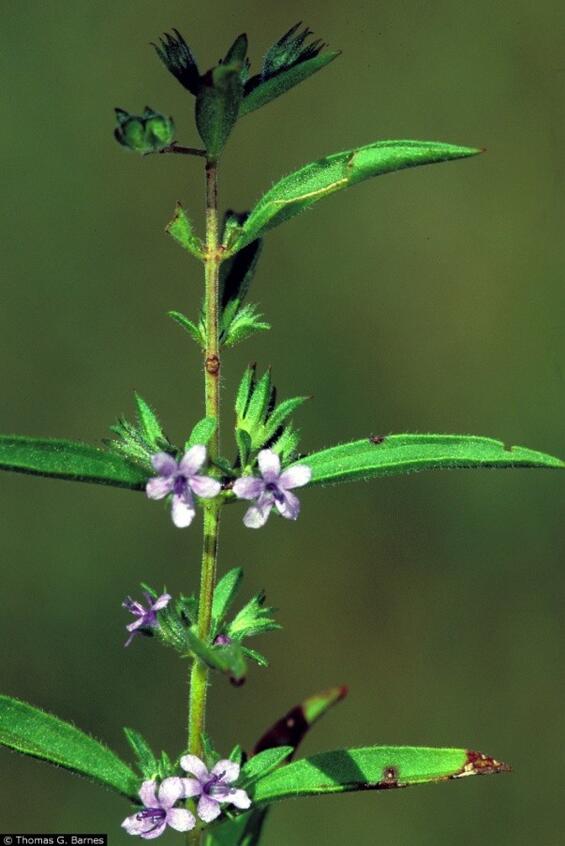- Scientific name: Trichostema brachiatum
- Species of Greatest Conservation Need (MA State Wildlife Action Plan)
- Endangered (MA Endangered Species Act)
Description

Thomas G. Barnes, University of Kentucky @ USDA-NRCS PLANTS Database / Barnes, T.G., and S.W. Francis. 2004. Wildflowers and ferns of Kentucky. University Press of Kentucky.
False pennyroyal is an erect, blue-flowered, herbaceous annual in the Mint family (Lamiaceae or Labiateae) that grows from 2-4 dm (0.5-1.75 ft) high. The plant has minute, rather sticky hairs and many branches. False pennyroyal’s elliptic to lanceolate leaves are short-stalked and acute (pointed at the tip). Its small, pale blue flowers are borne on stalks that rise from the leaf axils (points where the leaves meet the stem) and occur in clusters of one to three at each axil. In addition, these blossoms have five corolla lobes; a five-parted, bell-shaped calyx with nearly triangular lobes; and four stamens, which occur in pairs. The 2.5-3 mm (about 0.1 in) long nutlets (small, dry, one-seeded fruits) mature from mid-August to late September. Some authorities classify false pennyroyal as Isanthus brachiatus.
Blue curls (Trichostema dichotomum) resembles false pennyroyal; however, the flowers of blue curls are terminal and have long, curling stamens that project out of the flower. The stamens of false pennyroyal either do not protrude or protrude only very slightly. American pennyroyal (Hedeoma pulegioides) also resembles false pennyroyal. Nevertheless, American pennyroyal has denser whorls of flowers and its leaves are often toothed.
Life cycle and behavior
False pennyroyal is an annual species that blooms in August.
Population status
False pennyroyal is currently listed as endangered in Massachusetts as Endangered. MassWildlife’s Natural Heritage & Endangered Species Program database has 3 records from 2 counties: Berkshire and Hampden. Two of those records are within the last 25-year period.
False pennyroyal is also considered rare in Connecticut, Maryland, Michigan, Nebraska, New Jersey, New York, and North Carolina. It was present historically in Vermont. Globally, the species appears to be secure. In Massachusetts, threats to false pennyroyal include habitat destruction and, in habitats where false pennyroyal may be shaded out, forest succession.
Distribution and abundance
The documented range of false pennyroyal extends from southern Quebec, Ontario, and Vermont to Minnesota and Nebraska, and south to Florida and Arizona.

Distribution in Massachusetts. 1999-2024. Based on records in the Natural Heritage Database.
Habitat
False pennyroyal is weed-like in its preference for open sunny exposures on dry, sandy soil, sandstone, or limestone. In other parts of its range, it can be found along stream banks. Specific habitats in Massachusetts include a disused lime quarry, the fissures in an open slab of sandstone, a railroad bed with crushed stone and gravel, and limestone rocks in an open pasture. Among the plants associated with false pennyroyal at these sites are tall cinquefoil (Potentilla arguta), ebony spleenwort (Asplenium platyneuron), common juniper (Juniperus communis), staghorn sumac (Rhus typhina), and white snakeroot (Ageratina altissima). Rare Massachusetts plants that have been found with false pennyroyal include Tradescant’s aster (Symphyotrichum tradescantii, threatened).
Healthy habitats are vital for supporting native wildlife and plants. Explore habitats and learn about conservation and restoration in Massachusetts.
Contact
| Date published: | May 7, 2025 |
|---|